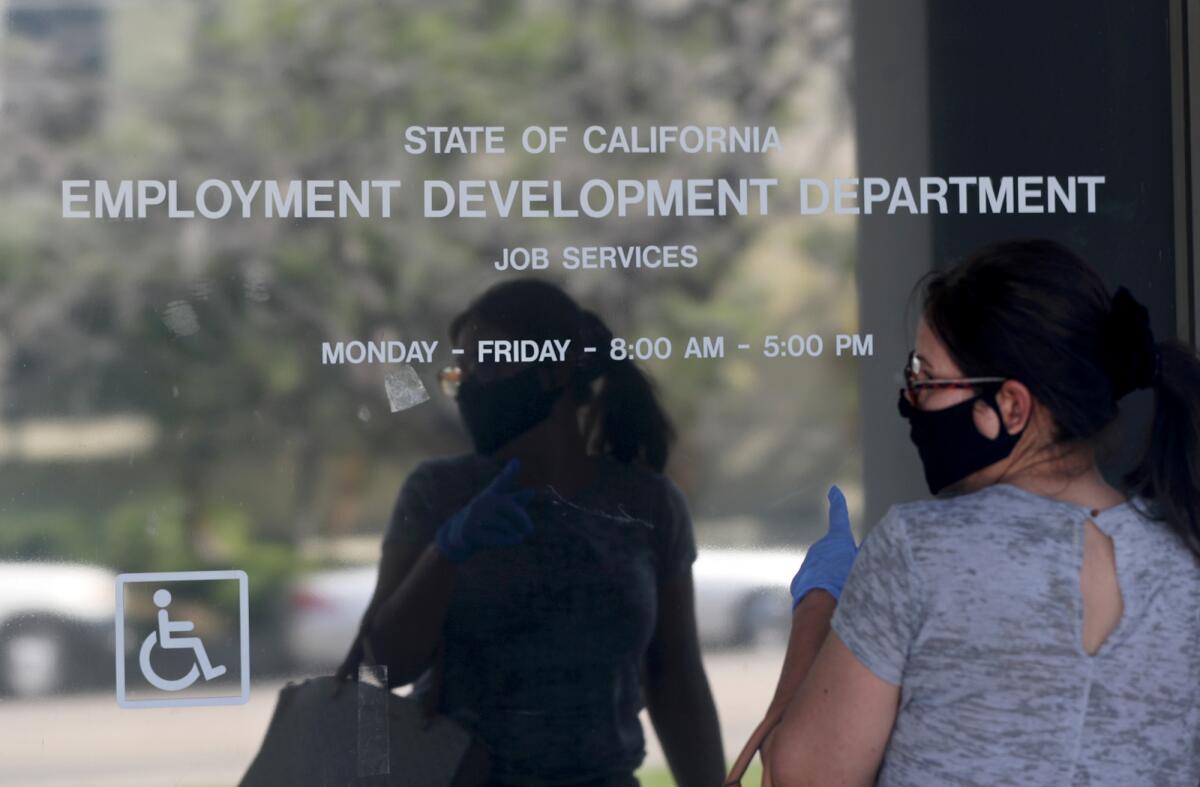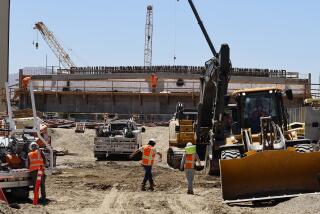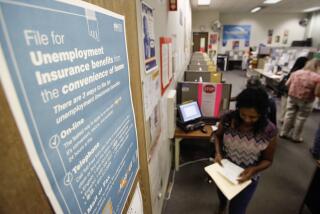California’s unemployment rate leaps to 15.5% as 2.3 million jobs vanish

- Share via
California’s unemployment rate nearly tripled from mid-March to mid-April as the state lost an unprecedented number of jobs across all sectors of its economy.
April’s jobless rate skyrocketed to 15.5%, up from 5.5% a month before, sweeping past the Great Recession’s peak of 12.3% a decade ago, state officials reported Friday.
Employers in the nation’s most populous state shed an unprecedented 2.3 million payroll jobs in just a month, a result of the COVID-19 pandemic, which has sickened more than 90,000 Californians and caused more than 3,600 deaths in the state so far.
The state lost a million more jobs in this single month than it did during the 2½-year period spanning the Great Recession.
“The extent of the job loss is breathtaking,” said Scott Anderson, chief economist of the Bank of the West in San Francisco. “We’ve wiped out a decade worth of job creation in a month and a half. I don’t think the size of the shock has really sunk in to folks.”
The Golden State’s jobless rate is higher than the nationwide rate of 14.7%, reflecting California’s reliance on tourism, hospitality and entertainment businesses frozen by the pandemic. To slow the spread of the coronavirus, state and local governments shut many of those businesses, and consumers who fear catching the virus have been hesitant to patronize the rest.
Legislators criticize the state Employment Development Department, citing phone and computer problems. Agency’s director says incoming funding will help.
Year over year, California payrolls were down 13.4%, the largest annual decline on record and slightly bigger than the U.S. decline of 12.9%.
And the pain will get worse. Since last month’s payroll survey, which charts jobs through the week of April 12, California has seen 1.4 million new unemployment claims, for a total of 5.1 million, the California Employment Development Department reported Thursday.
Given the new claims, the state’s jobless rate is likely to reach 23% in May — about the peak during the Great Depression in the 1930s, Anderson said. “We’re in uncharted territory.”
Even the April data “understates the true extent of the dislocation,” said Taner Osman, a Beacon Economics researcher. Since February, when the state’s jobless rate was just 3.9%, nearly a million workers have left the state’s labor force, a 5% contraction.
The COVID-19 pandemic is unleashing a wave of labor unrest harnessing front-line workers’ fear and anger across California and the nation.
Unemployment data include only workers who have lost a job or are seeking work. Given the economic collapse, many are not looking.
Moreover, the coronavirus’ blow to the economy is causing a drop in the tax revenue collected by state and local governments. If the federal government does not step in with massive aid, economists warn, that’s likely to trigger a new wave of layoffs affecting public sector jobs.
“After the 2007-to-2009 recession, it took over six years to regain all the jobs lost during the recession,” said Sung Won Sohn, an economist at Loyola Marymount University. “This recession is likely to be longer and the recovery slower.”
Though early lockdowns in California helped limit infections, he added: “In the foreseeable future, no one is about to go on a spending spree. Businesses will be careful about hiring people. Layoffs could be permanent, not temporary. There will be massive bankruptcies of small businesses.”
Regionally, job losses were highest in Southern California. In Los Angeles County, payrolls shrank by 691,300 in April and the unemployment rate soared to 19.6%. Orange County shed 226,200 jobs and registered a jobless rate of 13.8%. The Inland Empire lost 147,600 jobs and unemployment rose to 14.4%.
Northern California’s technology industry, which has boosted the state’s economy for decades, took a hit. Joblessness in Santa Clara and San Mateo counties reached 11.6% in April, higher than the recession-era peak of 10.5%.
“We’ve just never seen numbers like this before,” said Rachel Massaro, research director at the Silicon Valley Institute for Regional Studies. “To think of more than 160,000 Silicon Valley residents out of work is absolutely mind-boggling.”
California’s unemployment rate will register double digits through 2021 and may be as high as 8.5% two years from now, UCLA economists predict.
Every one of California’s 11 industry sectors lost jobs in April. The leisure and hospitality industry, which includes restaurants, hotels and theme parks, shed 866,200 jobs, more than twice as many as any other sector. That amounted to a decline of 44% in a single month.
Across 11 counties, the Red Lobster restaurant chain laid off 2,171 workers. Hard Rock Cafes in Los Angeles and San Francisco furloughed 321. The La Jolla Beach & Tennis Club let go 420.
“Workers in industries with the most jobs lost were already struggling before the COVID-19 downturn,” according to a paper this week by the California Budget & Policy Center. “The average weekly earning for workers in the leisure and hospitality industry — primarily restaurant and hotel workers — in February was $548, or about $28,500 annually, well below the income a family needs to meet basic needs.”
Job losses are now cushioned by a weekly supplement of $600 in unemployment benefits from the federal government, but that aid is scheduled to expire by the end of July. Meanwhile, workers who are not in the United States legally are not eligible for unemployment benefits or federal relief checks.
California employers with more than 75 workers must report plant closures and mass layoffs to the Employment Development Department under the Worker Adjustment and Retraining Notification, or WARN, law. In the past, the agency issued two reports a month, but so many companies have been laying off workers that the list is now updated daily.
The numbers reveal a rapid acceleration. In February, just 64 companies reported layoffs, totaling 7,164 workers. In March, 358 companies reported staff cuts, totaling 53,390 jobs. In April, the number soared to 3,204 employers laying off 320,886 workers.
Although the hope is that many of the layoffs are temporary, and the state is gradually allowing businesses to reopen, employment experts fear many of the job losses could be permanent.
“How many customers will believe it is safe to shop or dine out?” asked Lynn Reaser, an economist at Point Loma Nazarene University. “Of those who do feel safe, will they have the buying power, given job losses? Can companies even afford to reopen? The answers will determine the path of recovery.”
California’s retail sector also took a hit in April, with payrolls shrinking by 275,200 jobs, or 17%. Ross Stores Inc. shed 8,202 workers across the state. Goodwill of Southern California, which operates outlets across the region, laid off 1,856.
Higher-paid workers suffered less but nonetheless took extraordinary losses. The professional, scientific and technical services sector dropped 80,000 positions, or 6%. Information jobs, which include software developers, shed 40,000 jobs, or 7%.
Other sectors suffering big job losses in April included healthcare, whose payrolls shrank by 10%, or 246,500 positions, as patients fearing infection avoided going to doctors and dentists.
Administrative support positions dropped by 13%, or 150,000. The “other services” sector, which includes such businesses as dry cleaners and auto repair firms, shed 28% of its jobs, or 142,000. Construction dropped by 15%, or 132,000 jobs.
More to Read
Inside the business of entertainment
The Wide Shot brings you news, analysis and insights on everything from streaming wars to production — and what it all means for the future.
You may occasionally receive promotional content from the Los Angeles Times.


![INGLEWOOD, CA - APRIL 10: Jacob De Wilde [sic], Local 33, left, and Lesli Lytle, right, Local 44, of International Alliance of Theatrical Stage Employees, loads a car with food at a food distribution organized to celebrate Good Friday, in collaboration with the Los Angeles County Federation of Labor, the Forum, the City of Inglewood, Labor Community Services and the Los Angeles Regional Food Bank, and other organizations host a food distribution for more than 5,000 families, or 20,000 individuals, impacted by the COVID-19 crisis.Inglewood, CA. (Irfan Khan / Los Angeles Times)](https://ca-times.brightspotcdn.com/dims4/default/b3cbe75/2147483647/strip/true/crop/2400x1600+0+0/resize/840x560!/quality/75/?url=https%3A%2F%2Fcalifornia-times-brightspot.s3.amazonaws.com%2F79%2F57%2Fb4fd719c4c9181aacec4e6508684%2Fla-photos-1staff-522870-me-0410-unions-food-distribution-009.IK.jpg)










